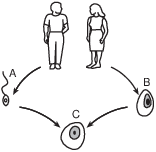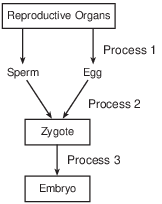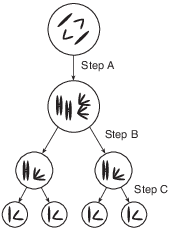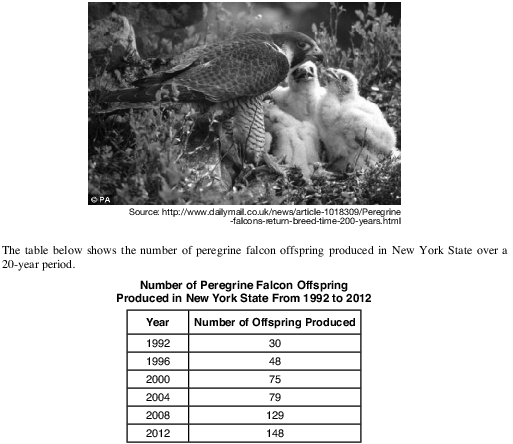Topic: Meiosis Fertilization Gametes And Zygote
Meiosis Fertilization Gametes And Zygote
The diagram below represents some stages that occur in the formation of an embryo.

Which statement best describes stage X?
(1) Stage X is a zygote and contains half the number of chromosomes as the body cells of the parents.
(2) Stage X is formed by the process of meiosis and is known as a gamete.
(3) Stage X is a zygote and is formed as a result of the process of fertilization.
(4) Stage X is formed by mitosis and is known as an egg cell.
The diagram below represents events that occur during sexual reproduction.

The stages labeled A, B, and C are necessary to ensure that the offspring will inherit
(1) half of their chromosomes from each parent
(2) double the amount of chromosomes from each parent
(3) pairs of chromosomes from each parent
(4) double the amount of chromosomes from one parent
The diagram below represents some stages in the process of development.

Stage 2 represents a cell that
(1) contains half the genetic material of an adult cell
(2) shows clear evidence of tissue differentiation
(3) has the complete genetic information to form an adult
(4) is genetically identical to one of the parents that produced it
Which sequence best represents sexual reproduction?
(1) mitosis → gametes → zygote → fertilization
(2) gametes → meiosis → mitosis → fertilization
(3) fertilization → gametes → meiosis → zygote
(4) meiosis → gametes → fertilization → zygote
The inability of sperm cells to move normally could prevent the production of offspring by interfering with
(1) meiosis
(2) mitosis
(3) fertilization
(4) differentiation
DNA replication occurs in preparation for
(1) mitosis, only
(2) meiosis, only
(3) both mitosis and meiosis
(4) neither mitosis nor meiosis
The diagram below represents the processes leading to the formation of a human embryo.

The correct sequence for processes 1, 2, and 3 represented in the diagram is

(1) 1
(2) 2
(3) 3
(4) 4
A kitten was born with black fur and green eyes. The fur and eye color of its parents are shown in the chart below.

Which statement helps explain why the kitten has black fur?
(1) Chromosomes present on the genes code for the characteristics of its fur.
(2) Genetic mutations always cause the fur color and eye color to change.
(3) Offspring receive genetic information from both parents.
(4) Gene expression is changed in every genera- tion, resulting in evolution.
The diagram below summarizes some of the steps in the development of humans.

All the genetic information needed for the organism to develop is first present at
(1) A
(2) B
(3) C
(4) D
Part of a process necessary for reproduction in complex organisms is represented below.

Step C results in the production of
(1) four zygotes that will develop into embryos
(2) embryonic cells that could unite and develop into an organism
(3) four cells that will recombine to form two offspring
(4) gametes that could be involved in the formation of a zygote
An alternative to the use of insecticides to combat the Mediterranean fruit fly is the Sterile Insect Technique (SIT). SIT involves the sterilization of male insects by radiation, which prevents the formation of functional male gametes. When these male insects mate with female insects of the same species, the result would be that
(1) only female offspring would be produced
(2) no offspring would be produced
(3) the offspring would have a reduced number of chromosomes
(4) the offspring would no longer be sterile
Twins Don’t Share Everything
…Chemicals called epigenetic markers can be attached to those [inherited] genes, like flags or balloons hanging off the sides of the DNA ladder. These don’t just change the look of the genes. Like pieces of tape stuck over a light switch, these markers can force a gene to remain turned on or off. The type of marker scientists studied in the twins generally sticks the switch in the off position so that some proteins don’t get made. And that means the proteins’ jobs won’t get done.
Every time a cell divides, new epigenetic markers may form. Foods, pollutants, and stress may all contribute to the development of new markers. So throughout our lives we tend to accumulate more and more. But a few are there from the day we’re born.
…His [Jeffrey Craig’s] team found that newborn twins have markers attached to different genes from the very start. It’s true in identical twins, which come from the same fertilized egg. It’s also true in fraternal twins, which come from different fertilized eggs. However, fraternal twins had more such differences than identical twins did.
Source: Science News for Students; July 31, 2012
State one reason why identical twins should have fewer genetic differences than fraternal twins. [1]
Allow 1 credit. Acceptable responses include, but are not limited to:
• — Fraternal twins arise from two fertilized eggs.
• — Identical twins are produced from one zygote/fertilized egg.
• — Identical twins come from the same fertilized egg.
All organisms need to reproduce for the continuation of their species. Discuss the process of reproduction in humans. In your answer, be sure to:
• identify one hormone present in a female that is involved in regulating the reproductive cycle [1]
• state one way the nucleus of a sex cell is different from the nucleus of a body cell [1]
• state how the normal chromosome number for humans is maintained from one generation to the next [1]
• identify one action by the mother that can influence the development of the embryo and state a result of that influence [1]
The student’s response to the bulleted items in the question need not appear in the following order.
• 13 Allow 1 credit for identifying one hormone present in a female that is involved in regulating the reproductive cycle. Acceptable responses include, but are not limited to:
• — progesterone
• — estrogen
• — LH
• 14 Allow 1 credit for stating one way the nucleus of a sex cell is different from the nucleus of a body cell. Acceptable responses include, but are not limited to:
• — It has half the normal chromosome number/half of the genes.
• — Sex cells are haploid/monoploid.
• — 23 chromosomes in sex cells, 46 in body cell
• 15 Allow 1 credit for stating how the normal chromosome number for humans is maintained from one generation to the next. Acceptable responses include, but are not limited to:
• — The egg and sperm each have half the normal chromosome number, and when they join, it restores the normal number for the species.
• — through the process of gamete production and fertilization
• — Each parent contributes half of the chromosomes.
• 16 Allow 1 credit for identifying one action by the mother that can influence the development of the embryo and stating a result of that influence. Acceptable responses include, but are not limited to:
• — Alcohol use can lead to Fetal Alcohol Syndrome.
• — Smoking can lead to low birth weight.
• — Poor nutrition can lead to underweight babies.
• — Drug use can lead to birth defects.
• — Good nutrition can lead to a healthy baby.
• — Drinking alcohol puts the embryo at risk.
• — Proper prenatal care might detect potential problems early so they can be treated.
The testes of a human male produce gametes. The process that produces these gametes differs from the process that produces new skin cells in the same individual.
Identify the type of cell division involved in each process. [1]
Skin cells:
Gametes:
Allow 1 credit for identifying the type of cell division involved in each process. Acceptable responses
• include, but are not limited to:
• — skin cells: produced by mitosis/mitotic cell division
• — gametes: produced by meiosis/meiotic cell division
Peregrine falcons are an endangered species in New York State. This crow-sized predator feeds primarily on birds. Starting in the 1940s, exposure to the pesticide DDT in their prey caused declines in the peregrine falcon population. These pesticides caused eggshell thinning, which drastically lowered breeding success. By the early 1960s, peregrine falcons no longer nested in New York State. After the United States banned DDT in 1972, efforts were made to reintroduce peregrine falcons into the Northeast. Since the 1980s, the peregrine falcons are once again breeding in many areas of New York State.

Directions: Using the information in the data table, construct a line graph on the grid provided, following the directions below.
Identify a body system in the falcon that was directly affected by DDT and led to the loss of nesting peregrine falcons from New York State in the early 1960s. Support your answer. [1]
Body system:
Support:
Allow 1 credit for identifying a body system in the falcon that was directly affected and led to the
• loss of nesting peregrine falcons from New York State in the early 1960s and supporting the answer. Acceptable responses include, but are not limited to:
• System:
• Reproductive
• Support: — Egg laying/egg shells are part of the reproduction of falcons.
• — The eggs had thin shells, which drastically lowered breeding success.
• — because it drastically lowered breeding success
